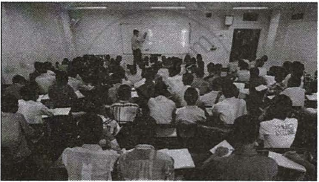Advertisements
Advertisements
प्रश्न
Solve for x and y:
9x - 2y = 108, 3x + 7y = 105
उत्तर
The given system of equation can be written as:
9x - 2y = 108 ……(i)
3x + 7y = 105 ……(ii)
On multiplying (i) by 7 and (ii) by 2, we get:
63x + 6x = 108 × 7 + 105 × 2
⇒ 69 x = 966
⇒ x = `966/69 = 14`
Now, substituting x = 14 in (i), we get:
9 × 14 – 2y = 108
⇒ 2y = 126 – 108
⇒ y = `18/2`=9
Hence, x = 14 and y = 9.
APPEARS IN
संबंधित प्रश्न
Find the value of k for which each of the following system of equations have infinitely many solutions:
2x − 3y = 7
(k + 2)x − (2k + 1)y − 3(2k − 1)
Show that the following system of equations has a unique solution:
`x/3 + y/2 = 3, x – 2y = 2.`
Also, find the solution of the given system of equations.
Find the value of k for which the system of linear equations has an infinite number of solutions:
2x + 3y = 7,
(k – 1)x + (k + 2)y = 3k.
Find the value of k for which the system of linear equations has an infinite number of solutions:
5x + 2y = 2k,
2(k + 1)x + ky = (3k + 4).
The sum of two numbers is 137 and their differences are 43. Find the numbers.
The difference between two numbers is 14 and the difference between their squares is 448. Find the numbers.
Find a fraction which becomes `(1/2)` when 1 is subtracted from the numerator and 2 is added to the denominator, and the fraction becomes `(1/3)` when 7 is subtracted from the numerator and 2 is subtracted from the denominator.
The sum of two numbers is 1/6 and the sum of their reciprocals is `1/3`. Find the numbers.
Solve the following pair of linear equations:
3x − 5y = 4
2y + 7 = 9x
Read the following passage:
|
A coaching institute of Mathematics conducts classes in two batches I and II and fees for rich and poor children are different. In batch I, there are 20 poor and 5 rich children, whereas in batch II, there are 5 poor and 25 rich children. The total monthly collection of fees from batch I is ₹9,000 and from batch II is ₹26,000. Assume that each poor child pays ₹x per month and each rich child pays ₹y per month.
|
Based on the above information, answer the following questions:
- Represent the information given above in terms of x and y.
- Find the monthly fee paid by a poor child.
OR
Find the difference in the monthly fee paid by a poor child and a rich child. - If there are 10 poor and 20 rich children in batch II, what is the total monthly collection of fees from batch II?

